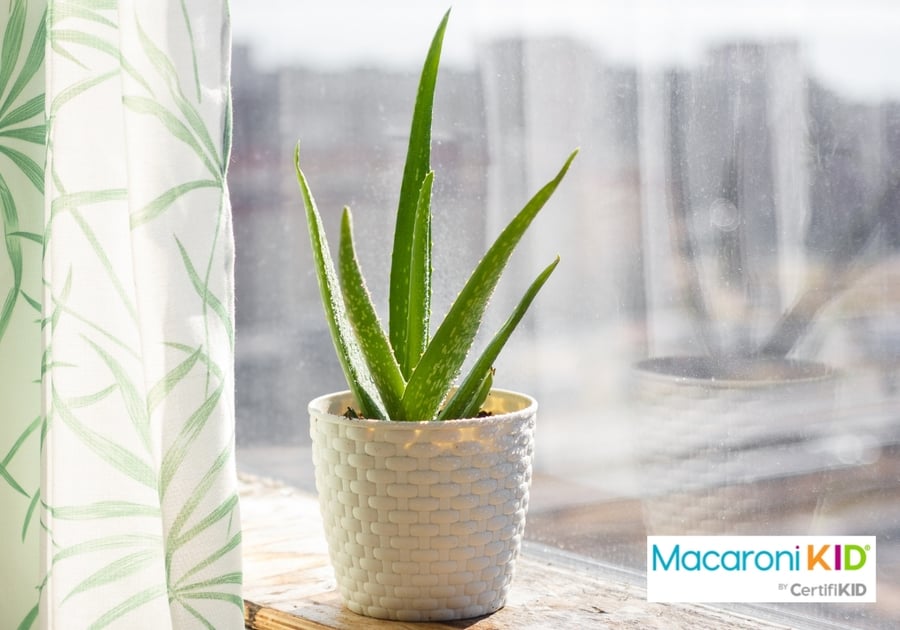Teaching children about how plants grow should not only be educational, but fun as well! Kids and dirt go hand-in-hand, so what better way to let them witness plant life first-hand than by letting them get their hands dirty with some easy-to-grow indoor plants.
Plus growing plants indoors has many benefits you can teach your kids about too. Plants are awesome!
Once these plants are potted, a school-aged child should be able to take care of the rest with just a little bit of coaching (No parent wants something ELSE to add to the to-do list!). Here are some easy-care plant ideas for that should make growing plants fun AND educational, while giving kids some responsibility:
*Please note that not all plants are safe for pets or children who still explore with their mouths.
1. Aloe Vera
Aloe Vera is a succulent that is easy to grow because it doesn't need to be watered very much. It likes soil to be completely dry before being watered again and the water needs to be able to drain freely. The best part is that aloe can be used topically on cuts, scrapes, and burns.
2. Snake Plant/Mother-In-Laws-Tongue
Not only does this have an interesting name, it's one of the easiest plants to grow. Pot it and leave it for a while, and it truly will be fine! It also has an unusual appearance, which makes it very interesting for little hands to touch.
3. Spider Plants
This is another plant that is great for a newbie or a child. It's very tolerant of many different types of situations. It continually makes new "spiderettes," which is a fun word for the little ones to say and learn!
4. Potatoes
Haven't we all found our potatoes sprouting before we used them up? Oops! You can turn that oops into a WIN next time by cutting off a chunk of the potato and sticking it down into a pot of dirt with the sprout up. It won't take long before it's growing tall and healthy! When it gets big enough, put the whole pot outside. Remind children that only the tuber portion of the potato plant is edible - the other parts of the plant contain solanine, which will make you sick in small amounts and is more toxic in large amounts.
5. Philodendron
This houseplant thrives indoors all year-round. They also grow super fast from cuttings. While this plant is easy to grow and is a very popular and common houseplant, it is also toxic to humans and pets if ingested. Be sure to remind children that this plant is only to be enjoyed with their eyes.
All of these plant options will allow your children to develop some autonomy, get their hands dirty, show responsibility, and learn more about plant life, all while keeping you (almost) task-free!
Plant Related Resources
Check Toxicity of Your Plants
If you already have plants in your home, you can check toxicity for humans and for pets online.
Poison Control
While we hope kids will only eat the greens on their plates and not in their planters, mistakes do happen. Be sure to get advice right away if any plants are ingested:
United States: Poison Control - 800-222-1222 (24 hours a day)
Canada: Find your local poison centre here
Emergency Plant and Mushroom Identification
If you do not know what plant your child or pet ingested, the Facebook group Poisons Help; Emergency Identification For Mushrooms & Plants can identify the plant quickly. This group is for CONFIRMED ingestion only (see below for groups to do casual, non-emergency identification). This group has an international team of over 200 botanists, mycologists, and other experts as admins who will identify plants and mushrooms through photos when there is confirmed ingestion so you can call your local poison control with a positive ID in order to get proper instructions for that specific plant (or rest easy if they confirm you have a harmless species). Only experts are allowed to comment on open cases. Please read the rules carefully and do not abuse this important resource. Since it is an international team, you may be waking a professional botanist in the middle of the night, so true emergencies only and use the below groups (where some of the same experts are also admin) to request identification when there is not an emergency.
Non-Emergency Identification
If you have an unknown plant or mushroom you would like to have identified, the following groups are recommended and monitored by some of the same experts as the emergency group, while leaving the feed for the emergency group as open as possible for those in need.



